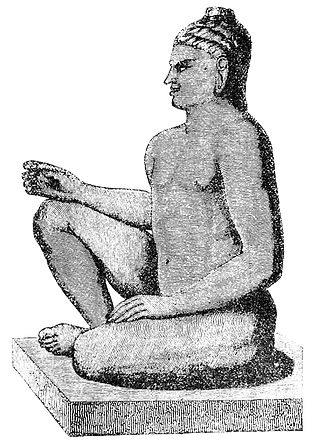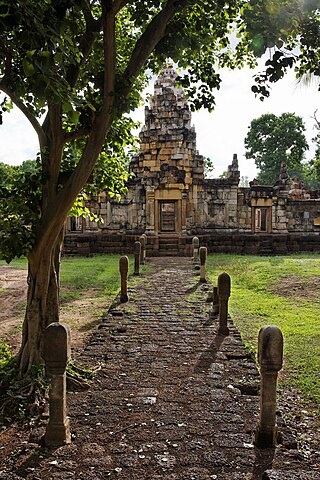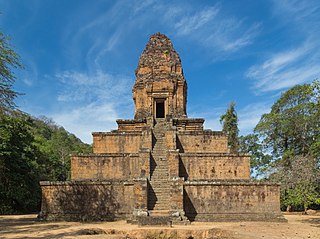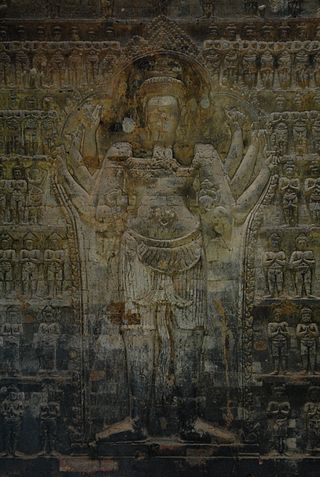Related Research Articles

Khmer architecture, also known as Angkorian architecture, is the architecture produced by the Khmer during the Angkor period of the Khmer Empire from approximately the later half of the 8th century CE to the first half of the 15th century CE.

Angkor, also known as Yasodharapura, was the capital city of the Khmer Empire, located in present-day Cambodia. The city and empire flourished from approximately the 9th to the 15th centuries. The city houses the Angkor Wat, one of Cambodia's most popular tourist attractions.

Phimeanakas or Vimeanakas at Angkor, Cambodia, is a Hindu temple in the Khleang style, built at the end of the 10th century, during the reign of Rajendravarman, then completed by Suryavarman I in the shape of a three tier pyramid as a Hindu temple. On top of the pyramid there was a tower, while on the edge of top platform there are galleries. Phimeanakas is located inside the walled enclosure of the Royal Palace of Angkor Thom north of Baphuon.

Jayavarman VII, known posthumously as Mahaparamasaugata, was king of the Khmer Empire. He was the son of King Dharanindravarman II and Queen Sri Jayarajacudamani. He was the first king devoted to Buddhism, as only one prior Khmer king had been a Buddhist. He then built the Bayon as a monument to Buddhism. Jayavarman VII is generally considered the most powerful of the Khmer monarchs by historians. His government built many projects including hospitals, highways, rest houses, and temples. With Buddhism as his motivation, King Jayavarman VII is credited with introducing a welfare state that served the physical and spiritual needs of the Khmer people.

Phnom Bakheng is a Hindu temple in the form of a temple mountain in Siem Reap Province, Cambodia. Dedicated to Shiva, it was built at the end of the 9th century, during the reign of King Yasovarman (889–910). Located atop a hill, it is nowadays a popular tourist spot for sunset views of the much bigger temple Angkor Wat, which lies amid the jungle about 1.5 km to the southeast. The large number of visitors makes Phnom Bakheng one of the most threatened monuments of Angkor. Since 2004, World Monuments Fund has been working to conserve the temple in partnership with APSARA.

Yasovarman I was an Angkorian king who reigned in 889–910 CE. He was called "Leper King".

Udayadityavarman II ruled the Angkor Kingdom from 1050 to 1066 A.D. He was the successor of Suryavarman I but not his son; he descended from Yasovarman I's spouse.

Koh Ker is a remote archaeological site in northern Cambodia about 120 kilometres (75 mi) away from Siem Reap and the ancient site of Angkor. It is a jungle filled region that is sparsely populated. More than 180 sanctuaries were found in a protected area of 81 square kilometres (31 sq mi). Only about two dozen monuments can be visited by tourists because most of the sanctuaries are hidden in the forest and the whole area is not fully demined.
Indravarman I was a ruler of Khmer Empire who reigned from Hariharalaya between 877/78 and 889/890 CE.

Sdok Kok Thom, or Sdok Kak Thom, is an 11th-century Angkorian temple in present-day Thailand, located about 34 kilometres (21 mi) northeast of the Thai border town of Aranyaprathet. The temple is in Khok Sung District, Sa Kaeo Province, near the village of Ban Nong Samet. It is regarded as the largest Angkorian temple in eastern Thailand. The temple was dedicated to the Hindu god Shiva. Constructed by a prominent priestly family, Sdok Kok Thom is the original site of one of the most illuminating inscriptions left behind by the Khmer Empire, which ruled much of Southeast Asia from the end of the 9th century to the 15th century.
Jayavarman VI was king of the Khmer Empire from about 1080 to 1107 AD.
Jayavarman V was a ruler of the Khmer Empire from his state temple, Jayendranagari, at Jayendrapura. During his reign, the Khmer Empire had 20 cities or pura.

Hariharalaya was an ancient city and capital of the Khmer empire located near Siem Reap, Cambodia in an area now called Roluos. Today, all that remains of the city are the ruins of several royal temples: Preah Ko, the Bakong, Lolei.
Rajendravarman II was the king of the Khmer Empire, from 944 to 968 AD.

Harshavarman I was an Angkorian king who reigned in 910–923 CE. He is mentioned by David P. Chandler, who is one of the foremost western scholars of Cambodia's modern history.

Ishanavarman II was an Angkorian king who is believed to have ruled from 923 to 928. His empire may have been confined to Angkor and the area around Battambang to the west.
Harshavarman II was an Angkorian king who ruled from 941 to 944. He succeeded his father in 941; however, his reign at Koh Ker was brief and "characterized by conflict". His cousin, Rajendravarman II, wrestled the power away from him and moved the capital back to Yashodharapura. He died in 944 and received the posthumous name of Brahmaloka.
Harshavarman III was a king of Khmer who ruled from 1066 to about 1080 AD. He succeeded his elder brother Udayadityavarman II and his capital was the so-called Second Yasodharapura, which had its center in Baphuon, built by his brother, and West Baray as its principal bàrày. He was married to queen Kambujarajalakshmi.

Devaraja was a religious order of the "god-king," or deified monarch in medieval Southeast Asia. The devarāja order grew out of both Hinduism and separate local traditions depending on the area. It taught that the king was a divine universal ruler, a manifestation of Bhagavan. The concept viewed the monarch to possess transcendental quality, the king as the living god on earth. The concept is closely related to the Indian concept of Chakravarti. In politics, it is viewed as the divine justification of a king's rule. The concept was institutionalized and gained its elaborate manifestations in ancient Java and Cambodia, where monuments such as Prambanan and Angkor Wat were erected to celebrate the king's divine rule on earth.
Arogayasala, or Arogyashala, are temple structures found in Cambodia and North-Eastern Thailand dating to the Khmer Empire. These Arogayasala served as medical facilities and are attributed to King Jayavarman VII whose reign lasted from c.1181 to c.1218.
References
- Chandler, David (1996). A History of Cambodia (4th ed.). Westview Press. ISBN 978-0-8133-4363-1.
- Coedès, George (1968). Walter F. Vella (ed.). The Indianized states of Southeast Asia. trans. Susan Brown Cowing. University of Hawai`i Press. ISBN 978-0-8248-0368-1.
- Higham, Charles (2001). The Civilization of Angkor. Phoenix. ISBN 1-84212-584-2.
- Rooney, Dawn F. (2005). Angkor: Cambodia's wondrous khmer temples (5th ed.). Odissey. ISBN 978-962-217-727-7.